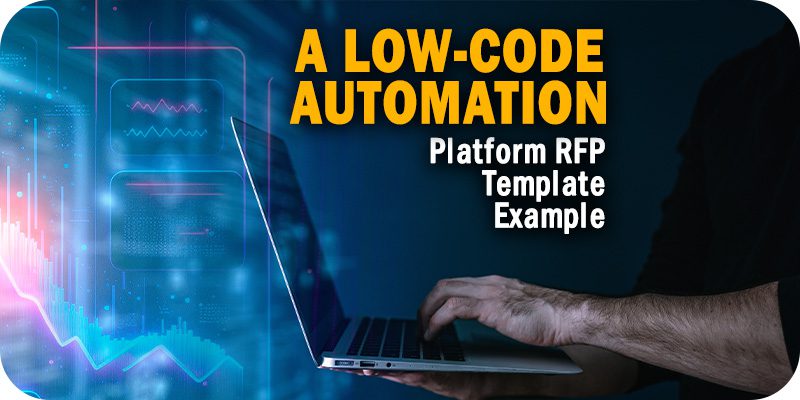A Low-Code Automation Platform RFP Template Example


The editors at Solutions Review have compiled this example low-code automation platform RFP template to help your organization select the best enterprise software for its business needs.
The rapid evolution of technology has brought a new era of business automation. Gone are the days when businesses relied heavily on manual labor to conduct their day-to-day operations. Today, low-code automation solutions have emerged as a viable option for companies looking to streamline their processes, reduce costs, and improve efficiency. However, choosing the right low-code system for your business can be daunting. One way to simplify the process is by using a request for proposal (RFP) template to solicit proposals from potential vendors.
In addition to simplifying the vendor selection process, an RFP template can offer other benefits. For example, it can help you standardize your requirements and evaluation criteria, making comparing proposals from different vendors easier. It can also help ensure you don’t overlook critical requirements or considerations when evaluating solutions. With that in mind, the Solutions Review editors have compiled an example low-code automation platform RFP template to help you and your team get started.
A Low-Code Automation Platform RFP Template Example
Implementing a low-code automation platform can give your company a notable boost in productivity, as it streamlines processes and allows your team to focus on more valuable tasks. By utilizing a well-crafted and researched RFP, you can maintain a systematic solution evaluation and selection process, making it far easier to find the best platform for your needs. Remember to customize it according to your organization’s unique requirements and objectives.
- Executive Summary: The best place to start any business relationship is with a brief introduction. You want prospective vendors to know about your organization’s background and goals, which will give them an idea of whether their platform will suit your needs. From there, clearly define your purpose and objectives for a low-code automation platform, and specify the desired outcomes you expect from the platform.
- Scope of Work: Describe the size and scale of your automation project, including the number of processes and applications that will play a role in the implementation. For example, this means defining the functional and technical requirements the low-code automation platform must fulfill and outlining the existing systems or third-party applications you will need to integrate with.
- Vendor Information: Once the introductory basics are done, it’s time to request details about the vendor’s background, experience, reputation, and financial stability. Inquire about the support services, training programs, documentation the vendor offers, and information on their roadmap for future product enhancements and updates.
- Platform Features and Capabilities: List the key features and capabilities you expect from the low-code automation platform (standard features include process modeling, workflow automation, data integration, and reporting/analytics). This is also to detail any specific requirements your industry or business requires, including your company’s expectations for scalability, security measures, and compliance with relevant regulations (e.g., GDPR, HIPAA).
- User Experience and Customization: Assessing the prospective platform’s user interface and ease of use for business users and developers is crucial. Request information on the platform’s customization options—such as UI branding, pre-built templates, and reusable components—and inquire about the platform’s mobile capabilities and responsive design.
- Deployment and Support: Determine the deployment options available (cloud-based, on-premises, hybrid) and associated costs. From there, inquire about the platform’s monitoring, maintenance, and support services, including response time, escalation procedures, and service-level agreements.
- Pricing and Licensing: Pricing is one of the essential parts of any software implementation project, so ensure you provide clear expectations around pricing structure (i.e., upfront costs, licensing, ongoing maintenance fees) and specify any budget limitations or constraints. You can also include information about contract terms, service-level agreements, and any potential penalties or termination clauses.
- References and Case Studies: Request references from organizations that have implemented the low-code automation platform. Inquire about successful use cases relevant to your industry or business domain. Seek feedback on the platform’s strengths and weaknesses from existing customers.
- Proposal Submission and Evaluation: Finally, provide clear instructions on how vendors should submit their proposals (i.e., format, deadline, delivery method). This involves explaining the evaluation criteria used to assess the proposals, the timeline for the evaluation process, and when vendors can expect to receive feedback.
NOW READ: The Top Low-Code Development Courses to Enroll in During 2023




















